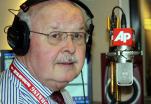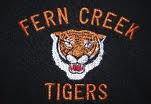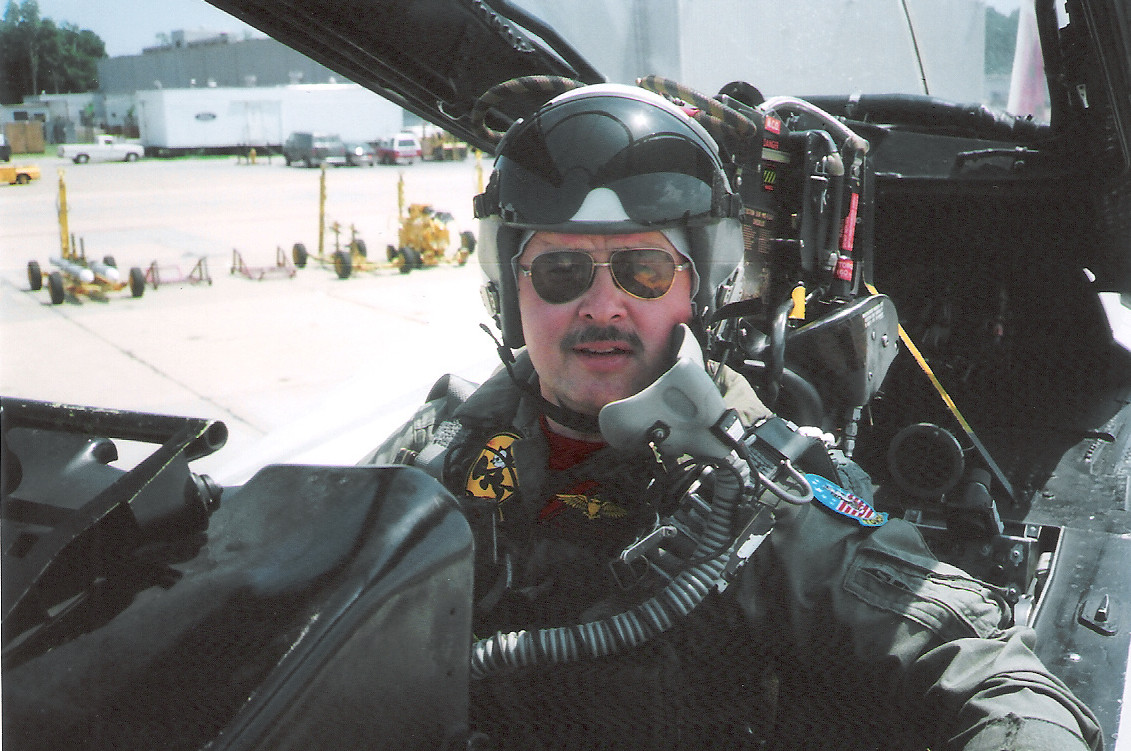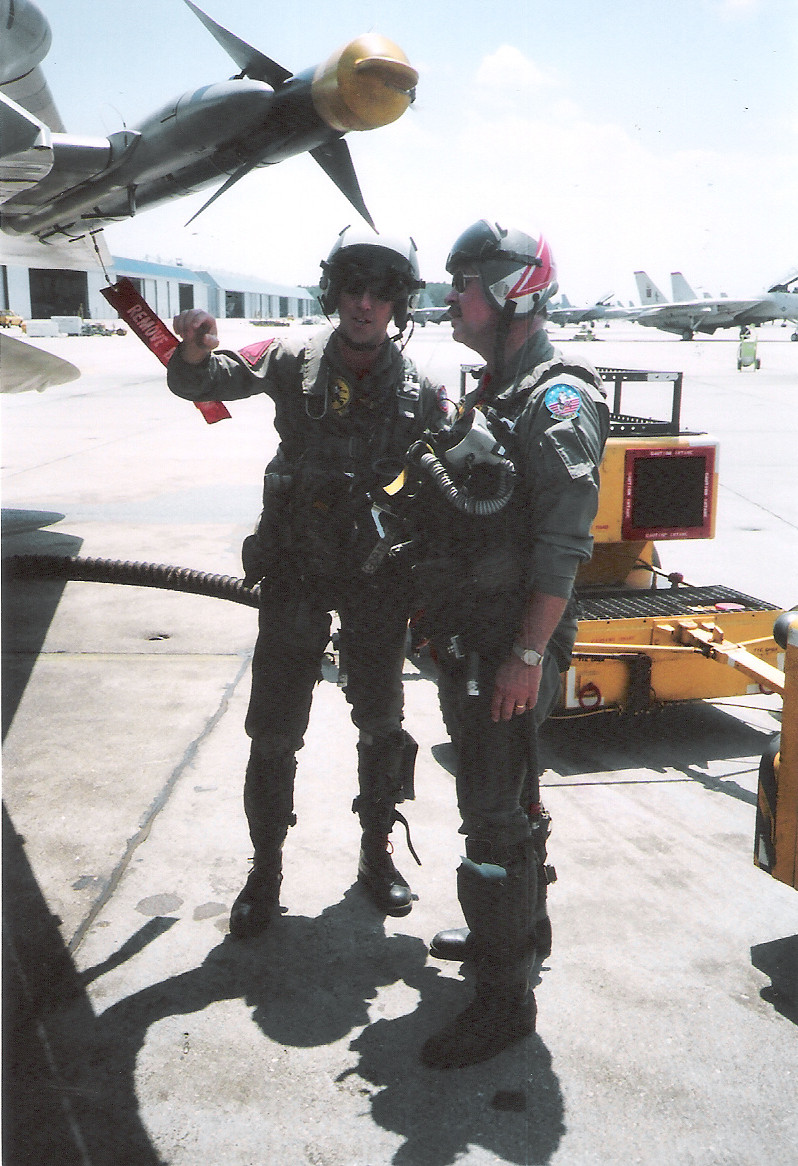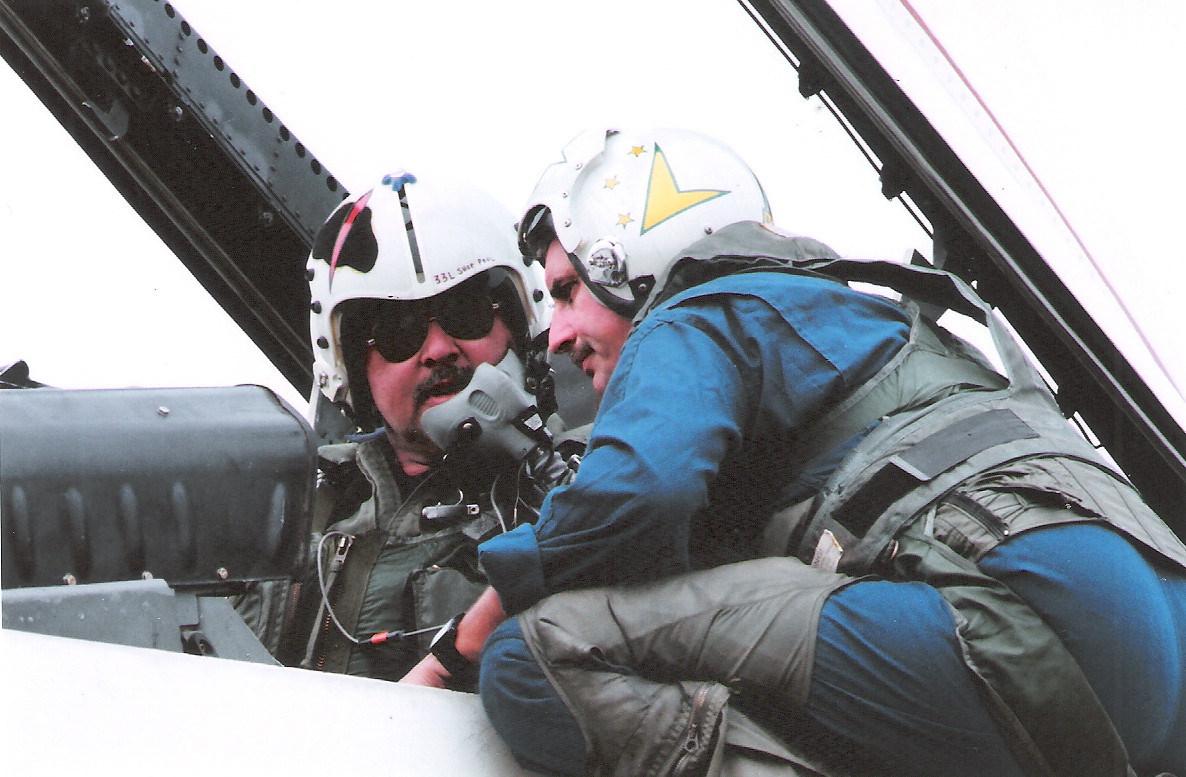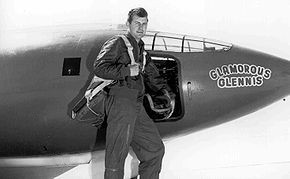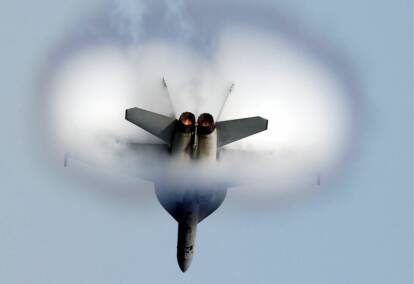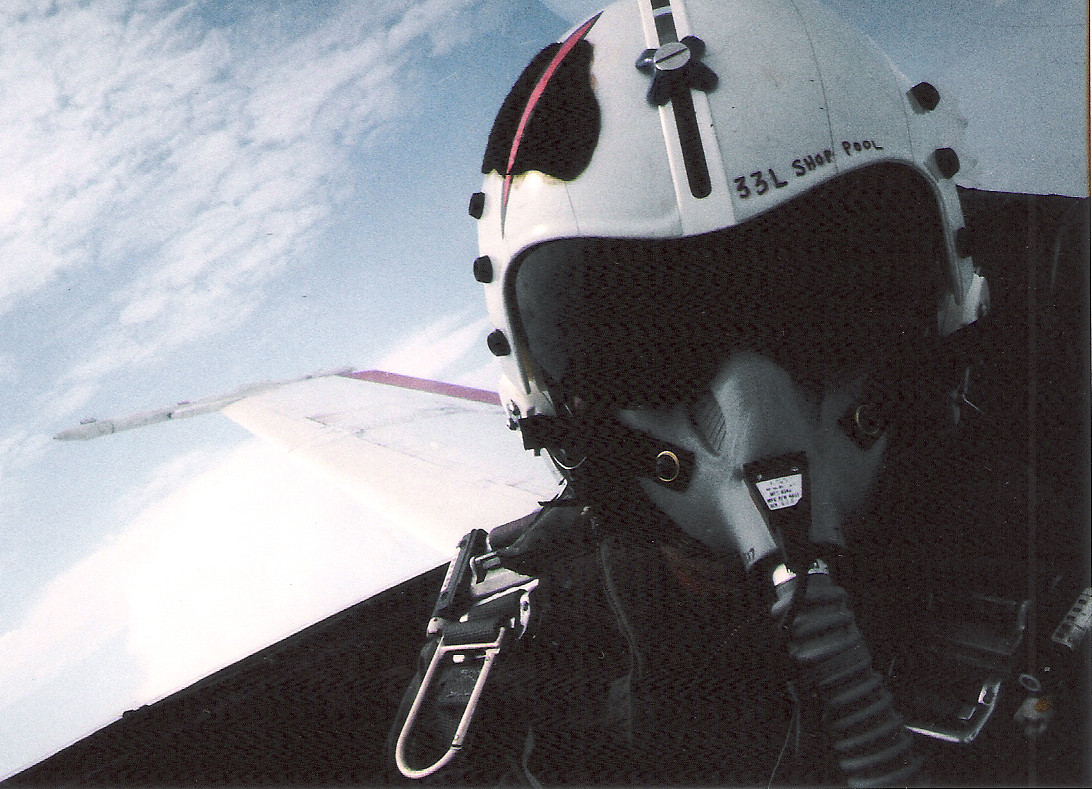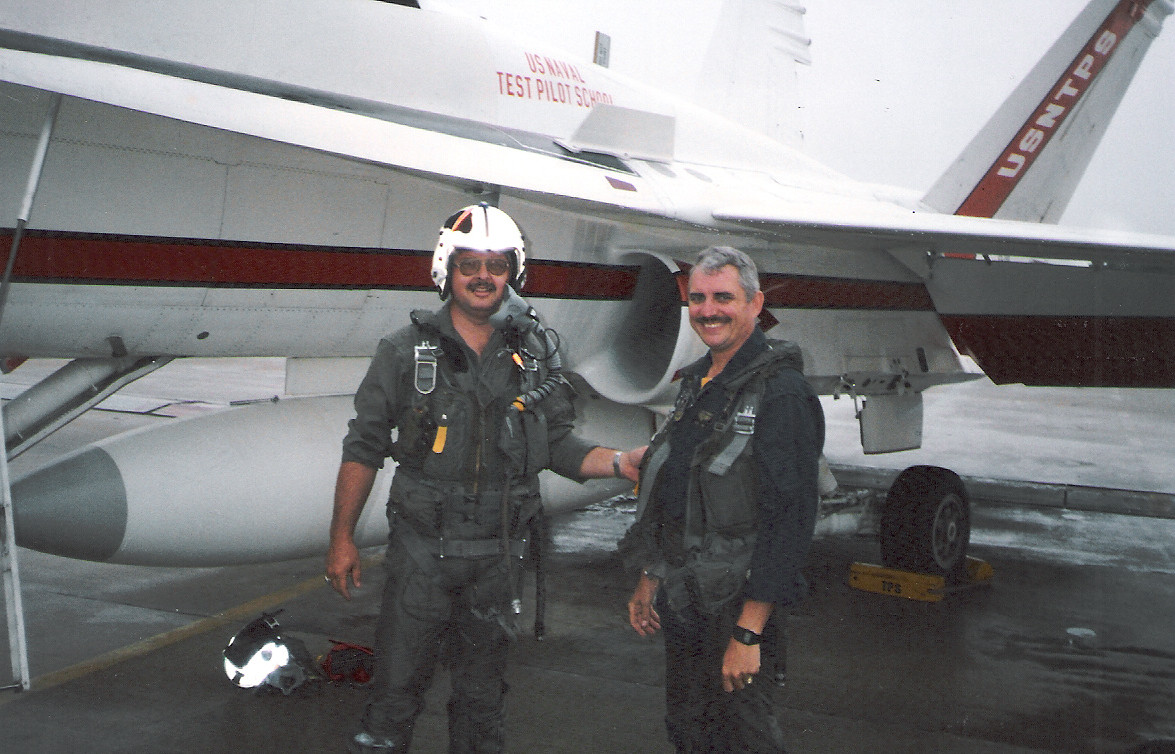Creeker Chronicles
A compendium of anecdotes and stories by
Contributing Editor Ross Simpson
Our intrepid correspondent, settled into the backseat of an F-14 Tomcat supersonic fighter jet, is poised for the ride of his life.
Chuck Yeager and the Bell X1 rocket plane, which is tiny,
but very fast. Yeager named the plane after his wife.
Commander Royal "Flash" Gordon shows Ross a Sidewinder heat-seeking missile. The F14 carried one on each wing tip. Locked on a target's heat source, the Sidewinder adjusts for evasive maneuvers and flies directly into the enemies exhausts.
Navy Captain "Dusty" Rhodes instructs Ross on how to punch out both of them, if Rhodes becomes incapacitated during flight.
At the moment a plane breaks the sound barrier it creates a
vapor cone unseen by those on board. Shown here, an F/A-18.
Unseen in the photo is Ross, behind the visor,
grinning like the Cheshire cat.
After the flight, Capt. Rhodes and Ross
celebrate that nobody had to be ejected.
Ross shares a tale of the two times he broke the
sound barrier, not including those in his Corvette
 I was about to celebrate my fifth birthday when Chuck Yeager was the first American pilot to break the sound barrier. He did it in the Bell X-1, an experimental rocket plane that was dropped from the wing of a B-29 at 45,000 feet, on October 14, 1947.
I was about to celebrate my fifth birthday when Chuck Yeager was the first American pilot to break the sound barrier. He did it in the Bell X-1, an experimental rocket plane that was dropped from the wing of a B-29 at 45,000 feet, on October 14, 1947.
 Forty years later, in 1987, I broke the sound barrier in the rear seat of an F/A-18D “Hornet” based at Naval Air Station Patuxent, on along the banks of Chesapeake Bay in Maryland.
Forty years later, in 1987, I broke the sound barrier in the rear seat of an F/A-18D “Hornet” based at Naval Air Station Patuxent, on along the banks of Chesapeake Bay in Maryland.
 The pilot that day was Captain “Dusty” Rhodes, commanding officer of the U.S. Naval Test Pilot School at Patuxent River, which was established in 1945 to ensure that the fleet has the best available aircraft and weapons systems. I figured if I was going to go “ballistic,” I better fly with the Navy’s number one test pilot.
The pilot that day was Captain “Dusty” Rhodes, commanding officer of the U.S. Naval Test Pilot School at Patuxent River, which was established in 1945 to ensure that the fleet has the best available aircraft and weapons systems. I figured if I was going to go “ballistic,” I better fly with the Navy’s number one test pilot.
 After briefing me on what we were about to do, Dusty and I walked downstairs, “suited up” and “stepped” to the waiting aircraft on the flight line. The crew chief made sure all eight points of my flight harness were properly connected to the ejection seat. He hooked up my oxygen hose to a fitting on a panel, to the left of the seat.
After briefing me on what we were about to do, Dusty and I walked downstairs, “suited up” and “stepped” to the waiting aircraft on the flight line. The crew chief made sure all eight points of my flight harness were properly connected to the ejection seat. He hooked up my oxygen hose to a fitting on a panel, to the left of the seat.
 The D-Model Hornet is dual-controlled, he explained. The multi-functioned joy stick tells the on-board computer where you want to go which then makes all the necessary adjustments to the twin rudders and slats on the wings. Before climbing into the front seat, Dusty showed me how to eject both of us, in case he became incapacitated during the mission.
The D-Model Hornet is dual-controlled, he explained. The multi-functioned joy stick tells the on-board computer where you want to go which then makes all the necessary adjustments to the twin rudders and slats on the wings. Before climbing into the front seat, Dusty showed me how to eject both of us, in case he became incapacitated during the mission.
 We posed for a few pictures, then Dusty lowered the glass canopy and taxied to the active runway.
We posed for a few pictures, then Dusty lowered the glass canopy and taxied to the active runway.
 “Ghost Rider One’ ready for takeoff,” radioed Rhodes to the tower, as he rolled onto the runway and lit the fuse. The thrust of a pair of Pratt & Whitney jet engines is like nothing you’ve ever experienced. Within seconds, Capt. Rhodes lifted the nose of the aircraft off the runway and screamed skyward. The steep climb was breathtaking.
“Ghost Rider One’ ready for takeoff,” radioed Rhodes to the tower, as he rolled onto the runway and lit the fuse. The thrust of a pair of Pratt & Whitney jet engines is like nothing you’ve ever experienced. Within seconds, Capt. Rhodes lifted the nose of the aircraft off the runway and screamed skyward. The steep climb was breathtaking.
 At our cruising altitude, Rhodes put the Hornet through aerial maneuvers that fighter pilots use in combat. I thought he was going to bend the wings in some of the high-G turns. After blowing the dust out of our heads, it was time to “set our hair on fire.”
At our cruising altitude, Rhodes put the Hornet through aerial maneuvers that fighter pilots use in combat. I thought he was going to bend the wings in some of the high-G turns. After blowing the dust out of our heads, it was time to “set our hair on fire.”
 “Ghost-Rider One requests permission to go supersonic,” said Rhodes, as he radioed the FAA control sector for the Washington to New York corridor. “We’ll be at 36 Angels [36,000 feet] on a heading of 230 degrees.”
“Ghost-Rider One requests permission to go supersonic,” said Rhodes, as he radioed the FAA control sector for the Washington to New York corridor. “We’ll be at 36 Angels [36,000 feet] on a heading of 230 degrees.”
 “Permission granted Ghost-Rider One. Contact New York approach when you complete the run,” replied the air traffic controller handling our flight.
“Permission granted Ghost-Rider One. Contact New York approach when you complete the run,” replied the air traffic controller handling our flight.
 Dusty didn’t diddle around. He ignited the afterburners and streaked north along the eastern seaboard. As we approached Mach 1, the speed of sound, the Hornet began to shake.
Dusty didn’t diddle around. He ignited the afterburners and streaked north along the eastern seaboard. As we approached Mach 1, the speed of sound, the Hornet began to shake.
 Breaking the sound barrier is an audible phenomenon and a visual experience. Scientists refer to the visual part as a “vapor cone” or “shock collar.” At sea level, the speed of sound is about 761 miles per hour. The speed of sound is commonly referred to a Mach 1, named after 19th century Austrian physicist Ernst Mach.
Breaking the sound barrier is an audible phenomenon and a visual experience. Scientists refer to the visual part as a “vapor cone” or “shock collar.” At sea level, the speed of sound is about 761 miles per hour. The speed of sound is commonly referred to a Mach 1, named after 19th century Austrian physicist Ernst Mach.
 When an airplane travels faster than the speed of sound, the waves of sound emitted by the plane can’t precede the plane; so, they accumulate behind the aircraft. When this shock wave passes, the listener hears a sonic boom. As a plane accelerates and breaks the sound barrier, a cone-shaped cloud of vapor forms around the aircraft. Air crews can’t see the shock collar or feel the sonic boom. They’re moving too fast.
When an airplane travels faster than the speed of sound, the waves of sound emitted by the plane can’t precede the plane; so, they accumulate behind the aircraft. When this shock wave passes, the listener hears a sonic boom. As a plane accelerates and breaks the sound barrier, a cone-shaped cloud of vapor forms around the aircraft. Air crews can’t see the shock collar or feel the sonic boom. They’re moving too fast.
 “We just broke the sound barrier,” Rhodes announced on the radio link in my helmet.
“We just broke the sound barrier,” Rhodes announced on the radio link in my helmet.
 “It doesn’t feel like we’re going supersonic,” I replied.
“It doesn’t feel like we’re going supersonic,” I replied.
 “Take the stick, and take us down along that cloud bank up ahead,” said Rhodes, “and then you’ll see how fast we’re going.”
“Take the stick, and take us down along that cloud bank up ahead,” said Rhodes, “and then you’ll see how fast we’re going.”
 As I moved the joy stick slightly to the left and down, the Hornet descended to the cloud bank. Leveling off, I put the left wing tip on the leading edge of the cloud formation. The clouds flying by were a blur, because we were flying at Mach 1.5, about 1,200 miles per hour, faster than a 30-06 bullet.
As I moved the joy stick slightly to the left and down, the Hornet descended to the cloud bank. Leveling off, I put the left wing tip on the leading edge of the cloud formation. The clouds flying by were a blur, because we were flying at Mach 1.5, about 1,200 miles per hour, faster than a 30-06 bullet.
 Rhodes took control of the aircraft and disengaged the afterburner; but, it took us 100 miles to slow down and turn around, for the return to base.
Rhodes took control of the aircraft and disengaged the afterburner; but, it took us 100 miles to slow down and turn around, for the return to base.
 Because the flight was over water, I had to go through the water survival course, not easy at age 45. The “dunker” was the hardest part.
Because the flight was over water, I had to go through the water survival course, not easy at age 45. The “dunker” was the hardest part.
 The course began when I climbed into a steel cage, configured to resemble a cockpit. It slides down a rail and plunges into the deep end of an Olympic-size indoor pool.
The course began when I climbed into a steel cage, configured to resemble a cockpit. It slides down a rail and plunges into the deep end of an Olympic-size indoor pool.
 When the cage hit the water, I took a huge, deep breath and waited for the dunker to spin upside down and hit the bottom of the pool, ten feet deep. I had to open the steel hatch and surface before my lungs burst.
When the cage hit the water, I took a huge, deep breath and waited for the dunker to spin upside down and hit the bottom of the pool, ten feet deep. I had to open the steel hatch and surface before my lungs burst.
 It was a tight fit, because I was wearing a flight suit, survival vest, helmet, steel-toed leather boots and fireproof flight gloves. Once on the surface, I had to swim the length of the 50-yard pool and back, in water being whipped by large fans. The objective after 50 yards is to crawl into a one-man rubber life raft.
It was a tight fit, because I was wearing a flight suit, survival vest, helmet, steel-toed leather boots and fireproof flight gloves. Once on the surface, I had to swim the length of the 50-yard pool and back, in water being whipped by large fans. The objective after 50 yards is to crawl into a one-man rubber life raft.
 By the time I reached the raft I was almost out of gas, but couldn’t get a flight card unless I completed the course. I had to reach down deep and call on an extra reserve of strength. I grabbed both sides of the slippery raft and with all the strength I had left, pulled myself into the raft.
By the time I reached the raft I was almost out of gas, but couldn’t get a flight card unless I completed the course. I had to reach down deep and call on an extra reserve of strength. I grabbed both sides of the slippery raft and with all the strength I had left, pulled myself into the raft.
 From the pool, we went to another area of the building, where I climbed into an ejection seat, set in a cockpit simulator. When told to “eject,” I was instructed to reach between my legs and pull the ejection handle. When I did, a rocket ignited under my butt and blew the ejection seat up a slanted rail, to the top of the building. The ejection seats are different in the F/A-18 Hornet and the F-14 Tomcat, and because I knew I would be flying an F-14 in the near future, I asked if I could also qualify on that seat.
From the pool, we went to another area of the building, where I climbed into an ejection seat, set in a cockpit simulator. When told to “eject,” I was instructed to reach between my legs and pull the ejection handle. When I did, a rocket ignited under my butt and blew the ejection seat up a slanted rail, to the top of the building. The ejection seats are different in the F/A-18 Hornet and the F-14 Tomcat, and because I knew I would be flying an F-14 in the near future, I asked if I could also qualify on that seat.
 “If you don’t mind being an inch shorter,” said the Navy flight surgeon who explained that the shock of ejection, especially two, back-to-back, would compress my spinal column. I stood 6’ 2” before being fired up separate rails, and have been 6’1” since that day.
“If you don’t mind being an inch shorter,” said the Navy flight surgeon who explained that the shock of ejection, especially two, back-to-back, would compress my spinal column. I stood 6’ 2” before being fired up separate rails, and have been 6’1” since that day.
FLYING WITH FLASH
 Three years later, in June 1990, before going to Saudi Arabia to cover Operation Desert Storm, I flew with the Tomcatters from VF-31, the second oldest fighter squadron in the Navy, which has proudly displayed a caricature of Felix the Cat on the tails of its aircraft since 1946. They’re based at Oceana Naval Air Station, Virginia.
Three years later, in June 1990, before going to Saudi Arabia to cover Operation Desert Storm, I flew with the Tomcatters from VF-31, the second oldest fighter squadron in the Navy, which has proudly displayed a caricature of Felix the Cat on the tails of its aircraft since 1946. They’re based at Oceana Naval Air Station, Virginia.
 “Hi, I’m Flash,” said Commander Royal Pope Gordon II, then the executive officer of VF-31.
“Hi, I’m Flash,” said Commander Royal Pope Gordon II, then the executive officer of VF-31.
 “Any relation to General Royal Pope Gordon of the Confederate States of America?” I asked.
“Any relation to General Royal Pope Gordon of the Confederate States of America?” I asked.
 “Yeah, he was my great-grandfather,” replied Cmdr. Gordon, as he introduced me to members of his squadron who were “working up” for deployment to the Mediterranean, in case the U.S. went to war with Iraq. Saddam was still a month away from sending his troops into tiny Kuwait, but the scuttlebutt at Oceana was “war is inevitable.”
“Yeah, he was my great-grandfather,” replied Cmdr. Gordon, as he introduced me to members of his squadron who were “working up” for deployment to the Mediterranean, in case the U.S. went to war with Iraq. Saddam was still a month away from sending his troops into tiny Kuwait, but the scuttlebutt at Oceana was “war is inevitable.”
 Before walking to the aircraft, Commander Gordon briefed me and another air crew who would go toe-to-toe with us in the skies, 110 miles offshore, high over the Atlantic.
Before walking to the aircraft, Commander Gordon briefed me and another air crew who would go toe-to-toe with us in the skies, 110 miles offshore, high over the Atlantic.
 Lieutenant Chris Caron’s call sign, “Crash,” was earned for totaling a rental van during Aviation Officer Candidate School in Pensacola, Florida. Gordon’s regular Radar Intercept Officer, Lieutenant Commander Tom Reitmeyer, got his call sign, “Rooter,” for climbing into the sewers of Portugal, during a port call. All listened attentively as the executive officer rattled off details of the upcoming Aerial Combat Maneuvers (ACM).
Lieutenant Chris Caron’s call sign, “Crash,” was earned for totaling a rental van during Aviation Officer Candidate School in Pensacola, Florida. Gordon’s regular Radar Intercept Officer, Lieutenant Commander Tom Reitmeyer, got his call sign, “Rooter,” for climbing into the sewers of Portugal, during a port call. All listened attentively as the executive officer rattled off details of the upcoming Aerial Combat Maneuvers (ACM).
Crash and Rooter would be the adversaries during our mock aerial combat.
 “We’ll take off in full afterburners on Runway 5, turn right after cleaning up the jets, intercepting Oceana 175 outbound and climb to 15,000 feet, as we head to our operating area offshore,” said Gordon.
“We’ll take off in full afterburners on Runway 5, turn right after cleaning up the jets, intercepting Oceana 175 outbound and climb to 15,000 feet, as we head to our operating area offshore,” said Gordon.
 “F-14s don’t flip over if you have to abort on takeoff,” Gordon told us, “so unless there’s a fire in the cockpit, or I flat die on you, stay with the aircraft.
“F-14s don’t flip over if you have to abort on takeoff,” Gordon told us, “so unless there’s a fire in the cockpit, or I flat die on you, stay with the aircraft.
 Before donning a fireproof flight suit, G-harness to counteract the forces of gravity my body would absorb during the ACMs, survival vest and steel-toes boots, I spent time in the RIO trainer, learning how to “hook em,” (get missile lock) and “fry em,” (burn a bad guy) with an AIM-9 Sidewinder Missile. I’ve never seen so many dials and switches on an instrument panel as there are for the AWG-9 Airborne Weapon Control System.
Before donning a fireproof flight suit, G-harness to counteract the forces of gravity my body would absorb during the ACMs, survival vest and steel-toes boots, I spent time in the RIO trainer, learning how to “hook em,” (get missile lock) and “fry em,” (burn a bad guy) with an AIM-9 Sidewinder Missile. I’ve never seen so many dials and switches on an instrument panel as there are for the AWG-9 Airborne Weapon Control System.
 Between your legs in the backseat of a Tomcat is a joy stick which operates a computer mouse that “locks up” bogeys that appear on the radar scope in front of the ejection seat.
Between your legs in the backseat of a Tomcat is a joy stick which operates a computer mouse that “locks up” bogeys that appear on the radar scope in front of the ejection seat.
 An F-14 aircrew is like Siamese twins. In the air they think as one. “Before we can fight anyone, we’ve got to find ‘em,” explained Rooter, who pointed out that three of the five U.S. aces in Vietnam were back seaters.
An F-14 aircrew is like Siamese twins. In the air they think as one. “Before we can fight anyone, we’ve got to find ‘em,” explained Rooter, who pointed out that three of the five U.S. aces in Vietnam were back seaters.
MORE A LAUNCH THAN A TAKEOFF
 Flash Gordon graduated from Top Gun in 1979 and was regarded by his peers as the best F-14 driver in the Atlantic fleet. With more than 4,000 flight hours and 600 carrier landings under his belt and a chest full of medals, including three Navy Commendation Medals, two with Combat “V” for valor for leading the F-14 cover on the combined services raid on Libya in the spring of 1986. Gordon was also the Navy’s senior F-14 demonstration pilot.
Flash Gordon graduated from Top Gun in 1979 and was regarded by his peers as the best F-14 driver in the Atlantic fleet. With more than 4,000 flight hours and 600 carrier landings under his belt and a chest full of medals, including three Navy Commendation Medals, two with Combat “V” for valor for leading the F-14 cover on the combined services raid on Libya in the spring of 1986. Gordon was also the Navy’s senior F-14 demonstration pilot.
 After signing forms absolving the U.S. government of damages, in case of an accident, Flash and I went to the squadron’s equipment room and got dressed. Everything fit perfectly, including the size 7 ¾ helmet. After a quick check to make sure oxygen would flow into the mask we walked through the hangar doors and to the flight line where two dozen F-14s were parked.
After signing forms absolving the U.S. government of damages, in case of an accident, Flash and I went to the squadron’s equipment room and got dressed. Everything fit perfectly, including the size 7 ¾ helmet. After a quick check to make sure oxygen would flow into the mask we walked through the hangar doors and to the flight line where two dozen F-14s were parked.
 “Ours is 201,” said Flash and he returned a smart salute from his crew chief. “Any problems, Chief?” Gordon asked as he walked around the aircraft and duck-walked underneath the aircraft, looking for any hydraulic leaks that could signal a problem.
“Ours is 201,” said Flash and he returned a smart salute from his crew chief. “Any problems, Chief?” Gordon asked as he walked around the aircraft and duck-walked underneath the aircraft, looking for any hydraulic leaks that could signal a problem.
 “No sir, she’s ready to fly,” said the crew chief.
“No sir, she’s ready to fly,” said the crew chief.
 The temperature was in the 90s and humidity was high when Flash and I climbed up the left side of Gordon’s red-tailed F-14, one of two Tomcats in the squadron not painted blue and gray camouflage. The other aircraft belonged to the squadron commander.
The temperature was in the 90s and humidity was high when Flash and I climbed up the left side of Gordon’s red-tailed F-14, one of two Tomcats in the squadron not painted blue and gray camouflage. The other aircraft belonged to the squadron commander.
 The flight line at Oceana was noisy as Flash and I strapped into the Tomcat. Twin engines on other F-14s were spooling up. The sound was sinister, like a pack of wolves howling in the wilderness.
The flight line at Oceana was noisy as Flash and I strapped into the Tomcat. Twin engines on other F-14s were spooling up. The sound was sinister, like a pack of wolves howling in the wilderness.
 Oblivious to the deafening roar of jet engines starting around us, Flash went through his checklist, as the Tomcat’s twin Pratt & Whitney engines sprang to life. The turbofans, each capable of generating 20,000 pounds of thrust, sucked condensation from the air conditioning unit and created tiny tornadoes in front of the ramps, the engine intakes.
Oblivious to the deafening roar of jet engines starting around us, Flash went through his checklist, as the Tomcat’s twin Pratt & Whitney engines sprang to life. The turbofans, each capable of generating 20,000 pounds of thrust, sucked condensation from the air conditioning unit and created tiny tornadoes in front of the ramps, the engine intakes.
 “Ready back there?” asked Flash. “Let’s do it,” After lowering the canopy, we armed out ejection seats. The zero-zero system is designed to hurl air crews 175 feet into the air, even when sitting on the ground. Ejection seats are powered by three thrust-producing cartridges, plus a rocket motor. Sitting in an F-14 ejection seat that’s been armed is like sitting on six sticks of dynamite.
“Ready back there?” asked Flash. “Let’s do it,” After lowering the canopy, we armed out ejection seats. The zero-zero system is designed to hurl air crews 175 feet into the air, even when sitting on the ground. Ejection seats are powered by three thrust-producing cartridges, plus a rocket motor. Sitting in an F-14 ejection seat that’s been armed is like sitting on six sticks of dynamite.
 “If you’re ready back there, we’ll hit it,” said Gordon as he went to afterburners before releasing the brakes. The 25-ton Tomcat lunged forward and accelerated down Runway 5 like a slingshot dragster.
“If you’re ready back there, we’ll hit it,” said Gordon as he went to afterburners before releasing the brakes. The 25-ton Tomcat lunged forward and accelerated down Runway 5 like a slingshot dragster.
 “One hundred knots, rotating at 130, and we’ve got lift off,” Flash told me on the intercom, as two glowing orange afterburners and a trail of black, oily fumes marked our ascent. A mile ahead, I could see Crash and Rooter climbing over the ocean.
“One hundred knots, rotating at 130, and we’ve got lift off,” Flash told me on the intercom, as two glowing orange afterburners and a trail of black, oily fumes marked our ascent. A mile ahead, I could see Crash and Rooter climbing over the ocean.
 Cmdr. Gordon took off over the hotel at Virginia Beach, where my family was staying. I saw them waving as we got our “feet wet,” a Naval term for flying over water.
Cmdr. Gordon took off over the hotel at Virginia Beach, where my family was staying. I saw them waving as we got our “feet wet,” a Naval term for flying over water.
 Heading out to meet the enemy (Crash and Rooter), we did a 360 degree windup maneuver to demonstrate how the F-14 sustains Gs at low altitude, in full burners. It also gives the pilot a good indication how much punishment his passenger can take, before he pukes or passes out, or both.
Heading out to meet the enemy (Crash and Rooter), we did a 360 degree windup maneuver to demonstrate how the F-14 sustains Gs at low altitude, in full burners. It also gives the pilot a good indication how much punishment his passenger can take, before he pukes or passes out, or both.
 “Okay, we’re at 5,000 feet, hitting about 180 knots, almost 200 miles per hour,” said Flash, as he stroked in the afterburners again. “Can you feel ‘em kickin’ in?”
“Okay, we’re at 5,000 feet, hitting about 180 knots, almost 200 miles per hour,” said Flash, as he stroked in the afterburners again. “Can you feel ‘em kickin’ in?”
 “Yeah, I feel like I’m riding a rocket sled.”
“Yeah, I feel like I’m riding a rocket sled.” 
 I wasn’t physically prepared to absorb 6.5 Gs as Gordon rolled left and turned the Tomcat on a dime. The G-harness I was wearing pumped up like a giant blood pressure cuff, squeezing my guts and shoving them into my chest cavity. I tried to videotape the gut-wrenching turn, but couldn’t lift the camcorder off my lap. It weighed more than 70 lbs. and I was tipping the scales around 1,500 lbs.
I wasn’t physically prepared to absorb 6.5 Gs as Gordon rolled left and turned the Tomcat on a dime. The G-harness I was wearing pumped up like a giant blood pressure cuff, squeezing my guts and shoving them into my chest cavity. I tried to videotape the gut-wrenching turn, but couldn’t lift the camcorder off my lap. It weighed more than 70 lbs. and I was tipping the scales around 1,500 lbs.
 The force of the G’s violently slammed me into my seat. It was all I could do to stay conscious. Blood was rushing from head to legs in a torrent. Just when I thought I was going to die, Flash leveled off for a second before he turned the Tomcat on its twin tails and headed heavenward.
The force of the G’s violently slammed me into my seat. It was all I could do to stay conscious. Blood was rushing from head to legs in a torrent. Just when I thought I was going to die, Flash leveled off for a second before he turned the Tomcat on its twin tails and headed heavenward.
 “I’m going to convert that airspeed into altitude,” explained the XO, “and then come back over the top.”
“I’m going to convert that airspeed into altitude,” explained the XO, “and then come back over the top.”
 Thank goodness I listened to his crew chief. “He’ll want to take you to lunch at the Officer’s Club for steak and green peppers, but don’t do it. Tell him you’ve got to get your equipment squared away. Tell him anything, but don’t go,” whispered the crew chief, as he stuffed two packages of saltines into my flight suit.
Thank goodness I listened to his crew chief. “He’ll want to take you to lunch at the Officer’s Club for steak and green peppers, but don’t do it. Tell him you’ve got to get your equipment squared away. Tell him anything, but don’t go,” whispered the crew chief, as he stuffed two packages of saltines into my flight suit.
 “While Commander Gordon goes through his checklist before takeoff, cram these crackers into your mouth. They’ll soak up the acid your stomach is going to produce and you won’t puke all over my plane,” grinned the young sailor.
“While Commander Gordon goes through his checklist before takeoff, cram these crackers into your mouth. They’ll soak up the acid your stomach is going to produce and you won’t puke all over my plane,” grinned the young sailor.
ROSS HITS CRASH WITH ELECTRONIC BBs
 “They’ll be coming supersonic at us soon,” said Flash as he scanned the skies ahead of us and I scanned the radar scope in the rear. The powerful radar can discern fighter-size targets from more than 100 nautical miles, across a 120-mile wide scan sector. The look-down/shoot-down radar can even separate low-flying targets from surface clutter. An independent search-and-track system, with a 10:1 magnification TV camera tucked under the nose, provides visual target identification at 10 miles or more, far beyond the pilot’s eyes.
“They’ll be coming supersonic at us soon,” said Flash as he scanned the skies ahead of us and I scanned the radar scope in the rear. The powerful radar can discern fighter-size targets from more than 100 nautical miles, across a 120-mile wide scan sector. The look-down/shoot-down radar can even separate low-flying targets from surface clutter. An independent search-and-track system, with a 10:1 magnification TV camera tucked under the nose, provides visual target identification at 10 miles or more, far beyond the pilot’s eyes.
 “There they are, below us!” I yelled, as Gordon rolled right and pointed the slide-wing F-14 down into a steep, G-gathering dive. In a dogfight, regardless of the advantages you might have, if you can’t visually detect and keep sight of your opponent, you lose.
“There they are, below us!” I yelled, as Gordon rolled right and pointed the slide-wing F-14 down into a steep, G-gathering dive. In a dogfight, regardless of the advantages you might have, if you can’t visually detect and keep sight of your opponent, you lose.
 Before I could blink my eyes, we were engaged in rolling scissors, trying to flush Crash out in front of us by decreasing our airspeed and creating angles that his airplane couldn’t hack; but as we decreased airspeed, the dogfight rapidly degenerated into a “toilet bowl” maneuver.
Before I could blink my eyes, we were engaged in rolling scissors, trying to flush Crash out in front of us by decreasing our airspeed and creating angles that his airplane couldn’t hack; but as we decreased airspeed, the dogfight rapidly degenerated into a “toilet bowl” maneuver.
 At one point, both aircraft were falling toward the ocean, like leaves from a tree. Flash pressed the fight, getting too close for missiles or guns.
At one point, both aircraft were falling toward the ocean, like leaves from a tree. Flash pressed the fight, getting too close for missiles or guns.
 “You don’t always have to kill a guy with rockets or bullets to gain a victory,” explained the XO, “you can force him into the ocean or the ground. The hard deck is the ultimate kill in aerial combat.”
“You don’t always have to kill a guy with rockets or bullets to gain a victory,” explained the XO, “you can force him into the ocean or the ground. The hard deck is the ultimate kill in aerial combat.”
 The first engagement ended when Crash hit the hard deck at 10,000 feet.
The first engagement ended when Crash hit the hard deck at 10,000 feet.
 In the second ACM, roles were reversed; we became the hunted. Crash started from a position of strength, but Flash showed the youngster a “bit of leg” in what the XO called a “bogey-gathering turn,” that brought us back over the top, forcing another slow fight.
In the second ACM, roles were reversed; we became the hunted. Crash started from a position of strength, but Flash showed the youngster a “bit of leg” in what the XO called a “bogey-gathering turn,” that brought us back over the top, forcing another slow fight.
 Crash took the bait and bored in on the starboard quarter trying to get a missile lock on us. I was screaming, “Here he comes, Here he comes!” like Goose in “Top Gun,” when Viper was about to show Maverick he had a lot to learn about dog fighting.
Crash took the bait and bored in on the starboard quarter trying to get a missile lock on us. I was screaming, “Here he comes, Here he comes!” like Goose in “Top Gun,” when Viper was about to show Maverick he had a lot to learn about dog fighting.
 Just as Crash closed in for the kill, Flash showed me some of that “pilot stuff,” putting the old “Maverick move” on Crash, by pulling back on the stick, causing the 25-ton jet to act like a speed brake. As we shot nose high, Crash slid under us.
Just as Crash closed in for the kill, Flash showed me some of that “pilot stuff,” putting the old “Maverick move” on Crash, by pulling back on the stick, causing the 25-ton jet to act like a speed brake. As we shot nose high, Crash slid under us.
 “Take him. He’s yours,” said Gordon, as I switched from missiles to guns and put electronic BBs all over the canopy of the F-14 Lt. Caron was flying.
“Take him. He’s yours,” said Gordon, as I switched from missiles to guns and put electronic BBs all over the canopy of the F-14 Lt. Caron was flying.
 “One-Nothing,” Gordon announced as we broke contact and assumed the role of aggressor. It took about an hour to complete the six ACMs.
“One-Nothing,” Gordon announced as we broke contact and assumed the role of aggressor. It took about an hour to complete the six ACMs.
FASTER THAN A SPEEDING BULLET
After “turnin’ and burnin’ and yankin’ and bankin’” over the Atlantic, we climbed to 36,000 feet for the crème de la crème. Flash lit the afterburners and we went supersonic.
The Mach meter in the cockpit monitored our race to the speed of heat. Mach 1 point 3… 1 point 3.5 … Mach 1 point 4, about 1,200 miles per hour. When I mentioned I had flown Mach 1.5 in a Hornet, Flash increased our speed to Mach 1.55, about 1,300 mph. Unlike the F/A-18 Hornet which shook and rattled, the F-14 Tomcat purred like a nurtured cat.
 “Northrop Grumman isn’t known as the “Ironworks” for nothing,” said Flash, as he streaked across the sky.
“Northrop Grumman isn’t known as the “Ironworks” for nothing,” said Flash, as he streaked across the sky.
 The Tomcat has completed its useful life and has been retired from the fleet, replaced with the McDonald-Douglas F/A-18 Super Hornet. Fittingly, F-14s from VF-31 dropped the last bombs of Operation Iraqi Freedom. They flew into what was billed as “Tomcat Sunset,” in the summer of 2005
The Tomcat has completed its useful life and has been retired from the fleet, replaced with the McDonald-Douglas F/A-18 Super Hornet. Fittingly, F-14s from VF-31 dropped the last bombs of Operation Iraqi Freedom. They flew into what was billed as “Tomcat Sunset,” in the summer of 2005  The sun has also set on my flying days. I can no longer take the punishment of pulling 6-7 Gs in a high-performance jet fighter; but, a scale model of a red-tailed F-14 Tomcat that classmate Don Pierce made for me sits on a stand in my study, nose-high, a reminder of what it was like to live vicariously as a fighter pilot, for a couple of hours.
The sun has also set on my flying days. I can no longer take the punishment of pulling 6-7 Gs in a high-performance jet fighter; but, a scale model of a red-tailed F-14 Tomcat that classmate Don Pierce made for me sits on a stand in my study, nose-high, a reminder of what it was like to live vicariously as a fighter pilot, for a couple of hours.
